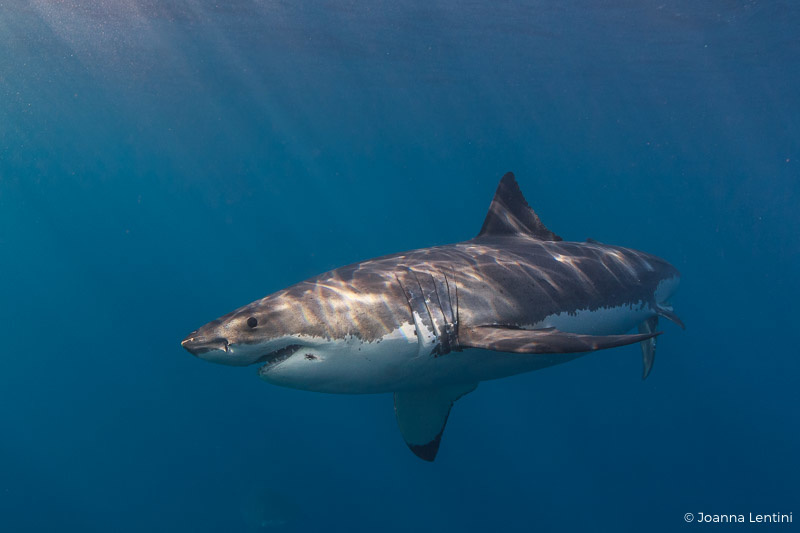As we are now in the middle of the white shark season in Guadalupe, Mexico, many shark lovers are preparing to make their way to the waters surrounding the volcanic island situated 150 miles off the western coast of the Baja Peninsula. Having photographed white sharks in various locations around the globe, I thought I’d put together a few tips for anyone keen to shoot them for the first time.
1. Fish-Eye and Wide-Angle Lenses: While I mostly shoot underwater with a fish-eye lens, I usually bring along my Canon 16-35mm wide-angle lens for a few reasons. First, different lenses provide different perspectives, which helps vary the body of work you create. The 16-35mm gives you a little more reach than a fish-eye and can be useful if the sharks are a little shy. It's also a good idea to have redundancies. If anything happens to one of your lenses, you have another option to shoot with.
2. The Surface: By including the surface in your images, you offer the viewer a sense of perspective, and it can provide nice reflections and texture to the image.
3. Strobes/Ambient Light: For aesthetic reasons, I personally shoot both ways. A bit of strobe can make the colors pop and can be especially important if you are in a deeper cage, farther from the light. Remember, the deeper we go underwater, the more color we lose. That’s not to say you shouldn't use strobes at the surface. Strobes can be used to fill in shadows, but are not as necessary at the surface. Play around with it and see what you prefer, because ultimately, that’s all that matters.
4. Alternate Between Cages: Multiple cages at different depths might not be an option with every operator and is perhaps something to consider when booking. For example, while cage-diving in South Africa, only one cage was attached to the boats, while in Mexico, the operator I dove with had the cages stacked at different depths.
5. Look Around: It might sound obvious, but can be easy to forget. The sharks sweep past from every direction.
6. Booties: As you’ll be inside a metal cage, you won’t have any need for fins. Having a pair of booties with a good grip can help keep you steady as the cage shifts. Steady feet mean steady shots.
7. Warmth: The last thing you want is to be in a position where you need to get out of the water because you are too cold. Bringing the appropriate gear: 5mm+ wetsuit, gloves, hood, vest, and warm topside clothing. These are so important to producing a good amount of shake-free images and not falling ill.
8. Mouths Agape: I think it’s fair to say the general public is still very frightened of sharks, although a lot has been changing for the better. Perpetuating this fear is not something I want to encourage by sharing sensationalist images.
9. Make a Pre-Dive Checklist: It can be easy to get lost in the excitement of the dives, so going into the trip with an idea of what sort of images you’d like to create and having a checklist is a good way to approach the experience. But of course, always be open to new ideas along the way.
Encountering any sort of pelagic life underwater can be an enthralling experience, let alone a massive white shark. It can be a little overwhelming the first time, so try to be as prepared as possible. I hope this list will help. If you’ve been cage-diving with white sharks and would like to add a suggestion, please do so below! If you have any questions, feel free to reach out.









Bonus Tip* - DO NOT watch Jaws before photographing sharks.
Baby Shark doo doo doo doo doo doo~!
I went on a cage in South Africa, but those on the surface. I want to go on one of this cages underwater, but my doubt is, how do they manage the speed of going down or up? I mean, somepeople like me requires more time to compensate when going scuba diving, both up and down. Also, how deep do you get? BTW, AWESOME pictures!!! Thanks!